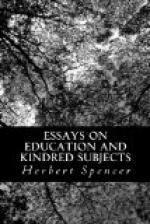In ourselves, distinguished from lower creatures as we are by feelings alike more powerful and more varied, parallel facts are at once more conspicuous and more numerous. We may conveniently look at them in groups. We shall find that pleasurable sensations and painful sensations, pleasurable emotions and painful emotions, all tend to produce active demonstrations in proportion to their intensity.
In children, and even in adults who are not restrained by regard for appearances, a highly agreeable taste is followed by a smacking of the lips. An infant will laugh and bound in its nurse’s arms at the sight of a brilliant colour or the hearing of a new sound. People are apt to beat time with head or feet to music which particularly pleases them. In a sensitive person an agreeable perfume will produce a smile; and smiles will be seen on the faces of a crowd gazing at some splendid burst of fireworks Even the pleasant sensation of warmth felt on getting to the fireside out of a winter’s storm, will similarly express itself in the face.
Painful sensations, being mostly far more intense than pleasurable ones, cause muscular actions of a much more decided kind. A sudden twinge produces a convulsive start of the whole body. A pain less violent, but continuous, is accompanied by a knitting of the brows, a setting of the teeth or biting of the lip, and a contraction of the features generally. Under a persistent pain of a severer kind, other muscular actions are added: the body is swayed to and fro; the hands clench anything they can lay hold of; and should the agony rise still higher, the sufferer rolls about on the floor almost convulsed.
Though more varied, the natural language of the pleasurable emotions comes within the same generalisation. A smile, which is the commonest expression of gratified feeling, is a contraction of certain facial muscles; and when the smile broadens into a laugh, we see a more violent and more general muscular excitement produced by an intenser gratification. Rubbing together of the hands, and that other motion which Dickens somewhere describes as “washing with impalpable soap in invisible water,” have like implications. Children may often be seen to “jump for joy.” Even in adults of excitable temperament, an action approaching to it is sometimes witnessed. And dancing has all the world through been regarded as natural to an elevated state of mind. Many of the special emotions show themselves in special muscular actions. The gratification resulting from success, raises the head and gives firmness to the gait. A hearty grasp of the hand is currently taken as indicative of friendship. Under a gush of affection the mother clasps her child to her breast, feeling as though she could squeeze it to death. And so in sundry other cases. Even in that brightening of the eye with which good news is received we may trace the same truth; for this appearance of greater brilliancy is due to an extra contraction of the muscle which raises the eyelid, and so allows more light to fall upon, and be reflected from, the wet surface of the eyeball.




